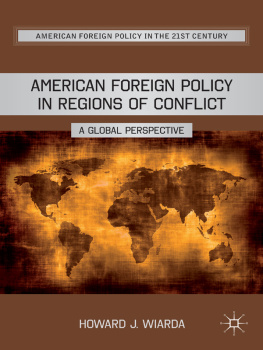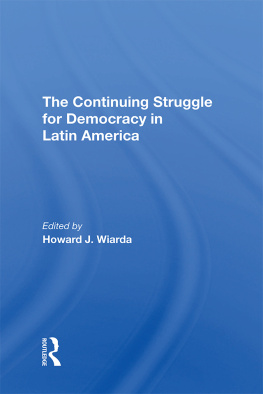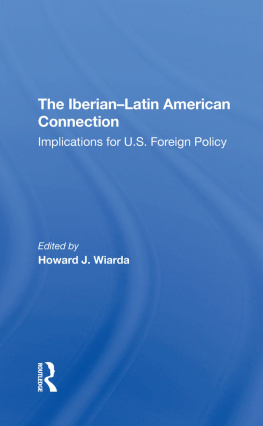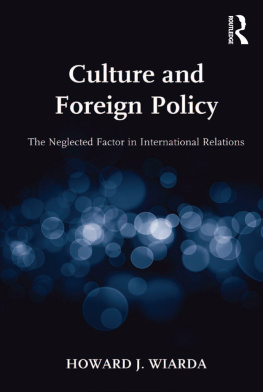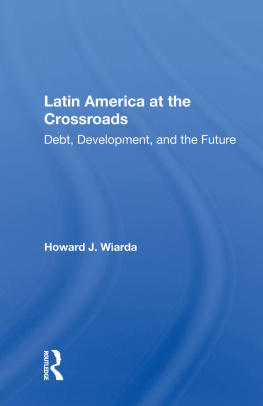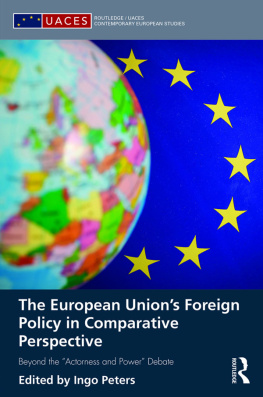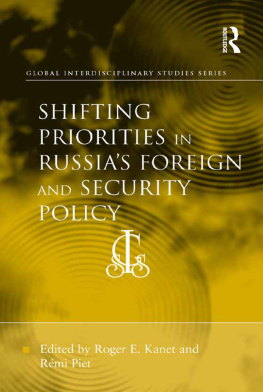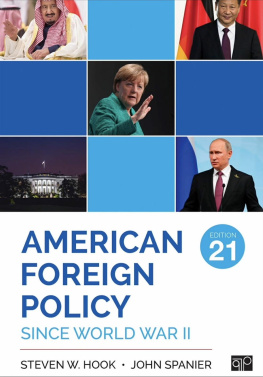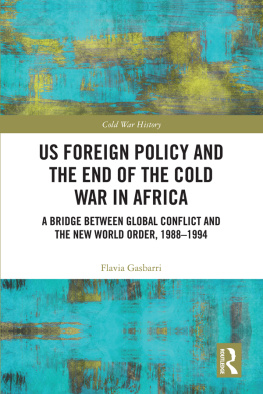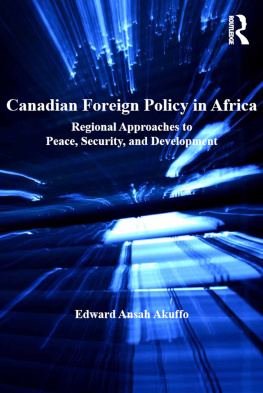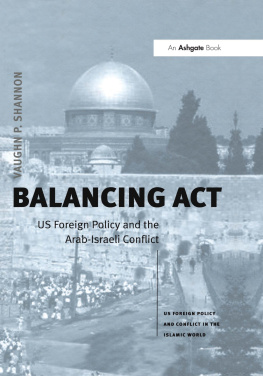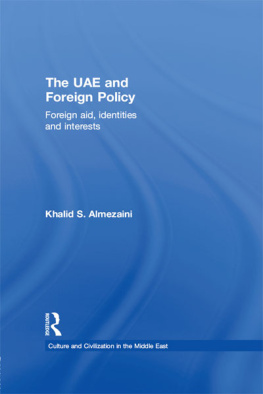American Foreign Policy in Regions of Conflict
AMERICAN FOREIGN POLICY IN THE 21ST CENTURY
Edited by Thomas H. Henriksen
Published by Palgrave Macmillan:
American Foreign Policy in Regions of Conflict: A Global Perspective
By Howard J. Wiarda
American Foreign Policy in
Regions of Conflict
A Global Perspective
Howard J. Wiarda


AMERICAN FOREIGN POLICY IN REGIONS OF CONFLICT
Copyright Howard J. Wiarda, 2011.
All rights reserved.
First published in 2011 by
PALGRAVE MACMILLAN
in the United Statesa division of St. Martins Press LLC,
175 Fifth Avenue, New York, NY 10010.
Where this book is distributed in the UK, Europe and the rest of the world, this is by Palgrave Macmillan, a division of Macmillan Publishers Limited, registered in England, company number 785998, of Houndmills, Basingstoke, Hampshire RG21 6XS.
Palgrave Macmillan is the global academic imprint of the above companies and has companies and representatives throughout the world.
Palgrave and Macmillan are registered trademarks in the United States, the United Kingdom, Europe and other countries.
ISBN: 9780230115026
Library of Congress Cataloging-in-Publication Data
Wiarda, Howard J., 1939
American foreign policy in regions of conflict : a global perspective / Howard J. Wiarda.
p. cm.(American foreign policy in the 21st century)
ISBN 9780230115026 (hardback)
1. United StatesForeign relations20092. Conflict managementUnited States. I. Title.
JZ1480.W49 2011
327.73dc22
2010048483
A catalogue record of the book is available from the British Library.
Design by Newgen Imaging Systems (P) Ltd., Chennai, India.
First edition: June 2011
10 9 8 7 6 5 4 3 2 1
Printed in the United States of America.
Note from the Editor
America confronts an altered and still-unfolding international landscape since the collapse of the Soviet Union. For over four decades, the United States marshaled its military, economic, political, and ideological energies to contain and defeat the USSR. The disintegration of the Soviet nemesis in 1991 transformed international relations and American foreign policy. The momentous end of the bipolar stand-off has ushered in an increasingly complex, less safe, and more unpredictable world with start of the twenty-first century.
The United States now faces a broad range of challenges. Among the seemingly traditional international affairs, Washington contemplates the return of great power rivalries with an ascendant China, resurgent Russia, and self-reliant European Union. Rising regional powers, such as India, Iran, and Brazil, complicate the global picture in ways unimagined during the Cold War.
Additionally, there are important and troubled bilateral relations with Pakistan, Venezuela, North Korea, and Mexico, to cite a few countries that scarcely registered on the State Departments radar in the previous era. Prospects for a Middle East peace and a stable region appear more elusive than ever despite global changes, adding another dimension to the ongoing turbulence in Afghanistan and Iraq.
Our new era is also marked by newor re-emergingproblems. Terrorism, piracy, ethnic conflicts, climate change, environmental degradation, nuclear proliferation, energy demands, economic globalization, and the role of international law on a host of issuesall (as well as other topics) beg to be addressed, navigated, or resolved.
This series recognizes that a page has turned in Americas global role. It also takes into account that foreign policy cannot concentrate alone on state-to-state negotiations in isolation from the intricacies of other burgeoning concerns. It seeks to shed light on Americas responses to the new reality. How the United States has respondedor should respondto a wide variety of twenty-first century issues worldwide forms the central theme of the series.
THOMAS H. HENRIKSEN
Senior Fellow
Stanford Universitys Hoover Institution
Preface
I began my academic career in 1965 as a comparative politics scholar specializing in Latin America. Our goal, that of my contemporaries and myself, was to acquire specialized knowledge, or area studies expertise, in the Latin America region. That meant a thorough immersion in both political science and the history, geography, economics, sociology, languages, and culture of Latin America. And the assumption was that we would use our specialized academic knowledge to help enlighten and improve U.S. policy toward the area.
Foreign policy then, in those halcyon years of John F. Kennedys New Frontier, Lyndon Johnsons Great Society, and such new and exciting foreign policy initiatives as the Peace Corps, the Alliance for Progress, and the Agency for International Development, would be based on a thorough, first-hand knowledge of the countries and areas affected. These were the years, the 1960s, of the politics of the developing areas and of a close connection between academia and policymaking, as we all struggled to understand the phenomenon of the new or emerging nations and their newfound importance on the world stage.
Policymaking in those years often looked to academia for knowledge and advice, while we in the academic world expected, perhaps naively, that our research findings would be widely read and used by policymakers. There was a close connection between analyzing development from an academic perspective and a policy of bringing development to less-favored countries. The assumption was that academic and specialized country or regional expertise would be used to inform public policy; sometimes we academic scholars had real policy influence.
But then, several large events transpired that made this close relationship between academia and policy strained and acrimonious:
1. The Vietnam War produced a sharp division between academics, especially those who studied Third World development, and the Johnson administration.
2. President Richard Nixon, suspicious that most academics were Democrats, cut many of the links and programs that had existed between academia and policymakers.
3. The rise and expansion of the Washington-based and savvy think tanksthe American Enterprise Institute (AEI), the Brookings Institution, the Center for Strategic and International Studies (CSIS), the Heritage Foundation, and other more specialized research cum policy groupsmeant policy-relevant advice would come mainly from these institutions and no longer from the nations universities.
4. Because of the ongoing Vietnam War, Watergate, and Nixons disgrace, academia became more radical, more politicized, and cut off from policymaking.
5. Meanwhile, the field of political science, including its subfields of international relations and comparative politics, became more quantitative, mathematical, and scientific, concerned more, like economics, with fashioning abstract mathematical modeling than proffering advice to policymakers.
By 1980, after having spent the first fifteen years of my career in academia, I was quite unhappy with the trends developing in political science and in academia more generally. During 19791981, I had retooled at Harvard Universitys prestigious Center for International Affairs (CFIA, now the Weatherhead Center) as a foreign policy specialist. And then in 1981 I was called to Washington to begin a twenty-plus-year stint in the think tank/policy spheres. I only returned full-time to academia in 2003 when I was offered an endowed chair in international relations and the headship of a brand new Department of International Affairs in a leading American university.
Next page
